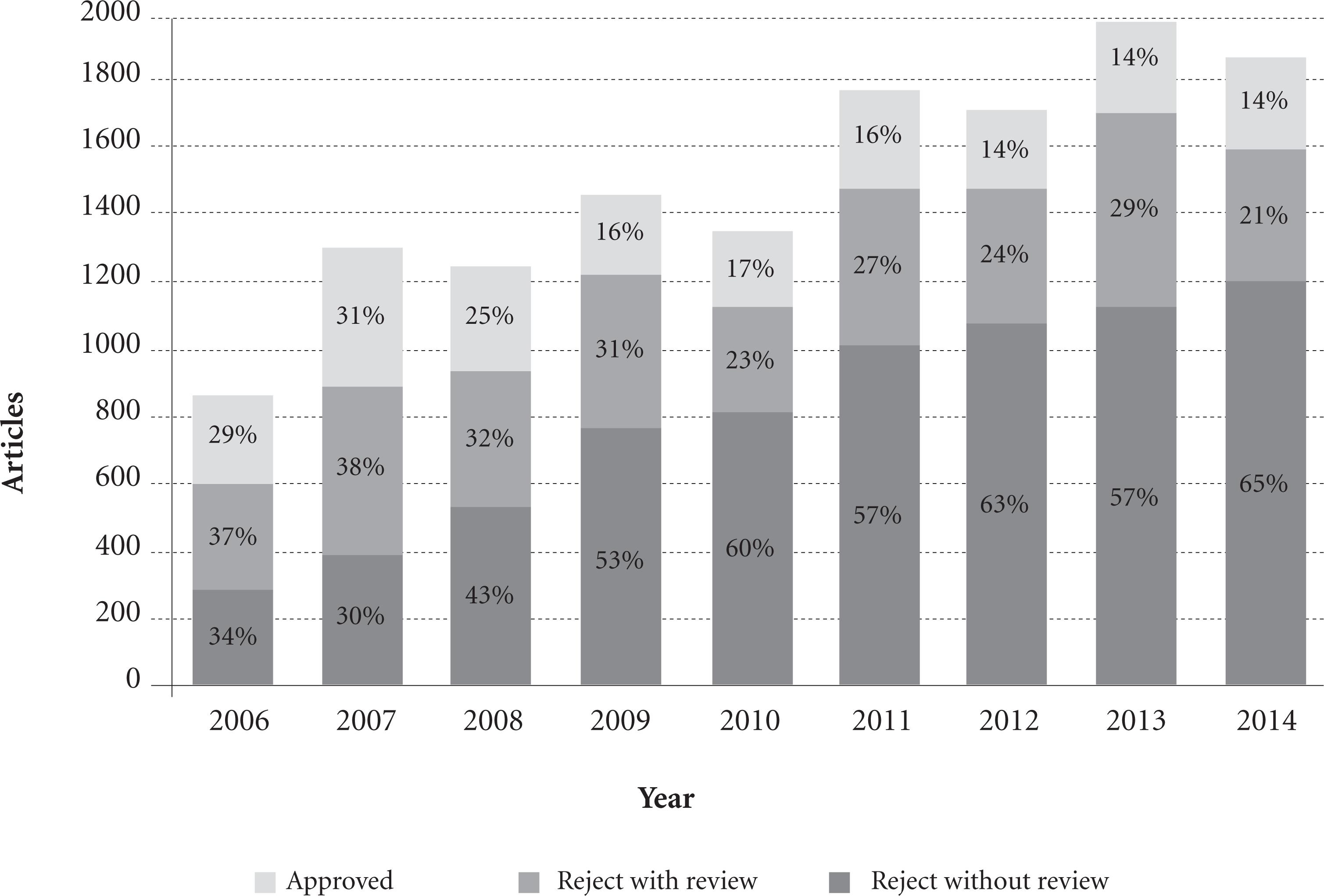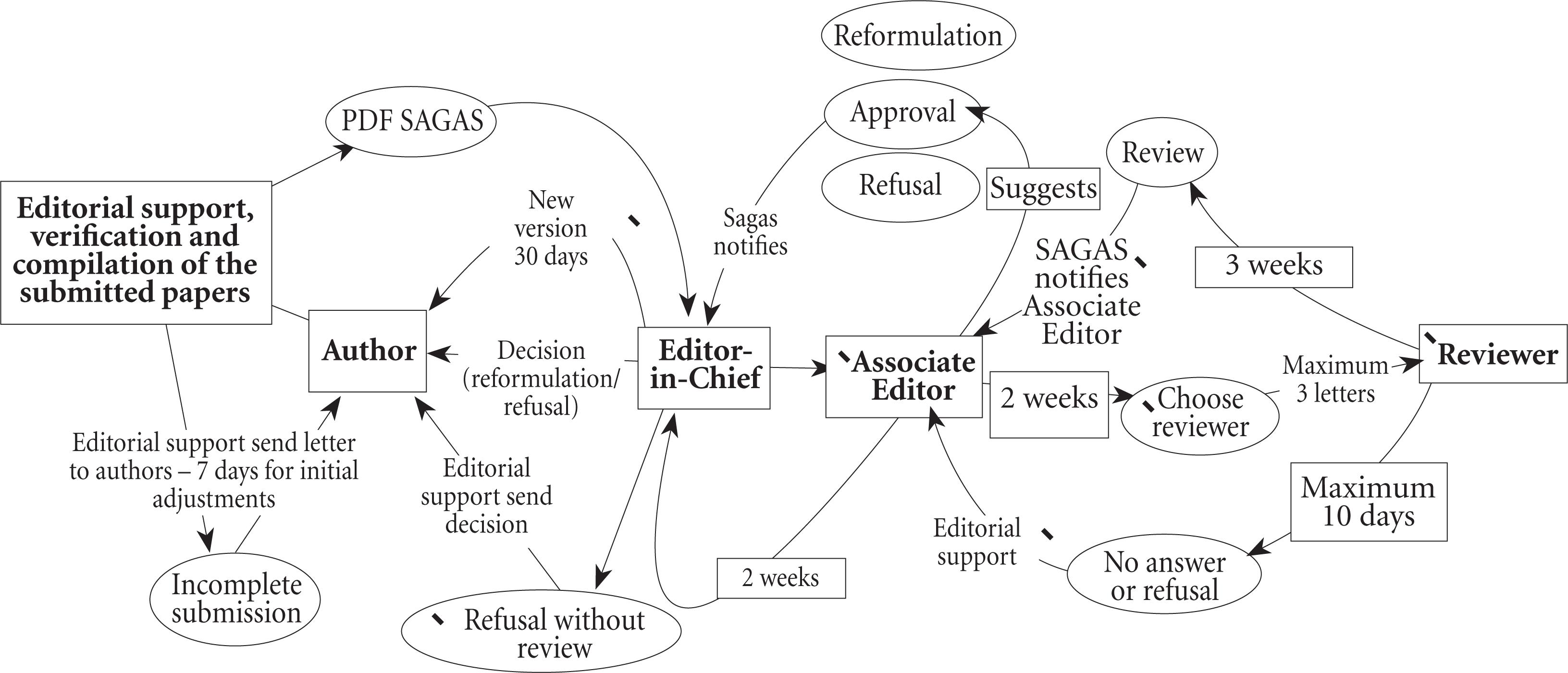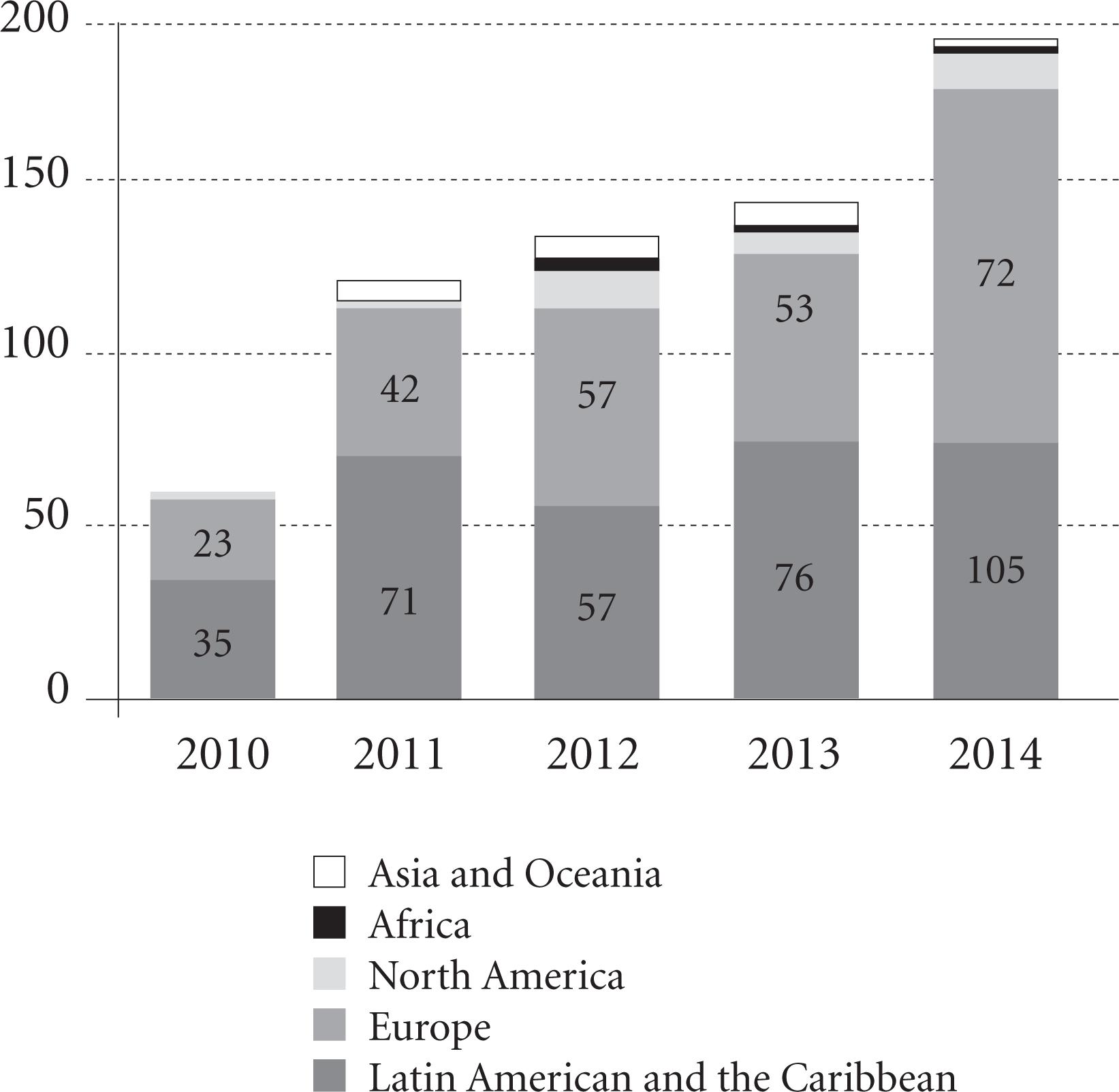Abstract
This article was written as part of the 20th-year commemorative issue of Ciência e Saúde Coletiva (C&SC). We take advantage of this opportunity to revisit the successful history of Cadernos de Saúde Pública (CSP)/Reports in Public Health in its 30 years of publication, progressing from a quarterly periodical with limited circulation to a monthly journal indexed in the main scientific databases. We also summarize some themes from our recent editorials, including the internationalization of scientific journals, the demand for relevant and original articles, plagiarism, and peer review. We also discuss the article submission management system developed by CSP and conclude with ideas on cooperation between journals in the public health field.
Keywords
Periodical publications; Scientific and technical publications
Introduction
The invitation to write an article in the issue celebrating the 20th anniversary of Ciência e Saúde Coletiva (C&SC) provides an opportunity to revisit our work at Cadernos de Saúde Pública (CSP)/Reports in Public Health, the two years we are completing as Editors-in-Chief, and the 30 years CSP celebrated in 2014. In the special issue dedicated to the CSP celebration (volume 10, number 1), we took great pleasure in paying tribute to Frederico Simões Barbosa, Luiz Fernando Ferreira, Paulo Buss, Sergio Koifman, Luis David Castiel, Mario Vianna Vettore, and Carlos Coimbra Jr., the Editors-in-Chief that preceded us and that helped consolidate CSP as an important channel for spreading scientific production in the public health field. In that issue we also published facsimiles of the editorials from the inaugural issue and from the 10th and 20th-year commemorative issues of CSP. Reading these editorials and the many other signed by Carlos Coimbra Jr. in his 20 years as Editor-in-Chief opens a window on the successful history of CSP, from a quarterly periodical with limited circulation to a monthly journal indexed in the main scientific journal databases.
Cadernos, as the journal is called informally, is published by the Sérgio Arouca National School of Public Health (ENSP) at the Oswaldo Cruz Foundation (Fiocruz). ENSP provides some 80% of the funding for CSP, with the rest coming from research funding agencies (CNPq and FAPERJ), subscriptions, and newsstand sales. The support from ENSP and the research agencies has been essential for CSP to maintain a highly qualified and professional staff, thereby guaranteeing regular publication and the adoption of a detailed graphic project. Since CSP joined the SciELO library in 1998, our journal has made its articles available with open access, without transferring costs to the authors.
The mission of CSP is to publish articles in the field of Public Health, featuring epidemiology, health planning, social sciences in health, environmental health, and other related areas. As Public Health has changed, dynamically incorporating new research questions and new disciplines, CSP has accompanied these trends, constantly striving for its pages to express the field's vitality.
The principal criteria for accepting articles are originality, methodological adequacy, and relevance to Public Health. To deal with the field's interdisciplinarity, CSP has 27 associate editors from different Brazilian and international research institutions that are academic leaders in their fields of expertise. One challenge is to pursue a balance in publishing articles from different areas in each issue, especially considering the extensive submission of articles in the area of epidemiology. In addition, the “Thematic”, “Perspectives”, and “Debate” sections publish opinions by outstanding authors on highly current topics in order for Cadernos to participate in the debate and reflection on relevant issues and policies that impact health and scientific development.
In the editorial in the issue celebrating the 30th anniversary of CSP, Nísia Trindade Lima coined the term “intellectual craftsmanship” to refer to the personal touch adopted by the editors of CSP throughout its various phases11 Lima NT. Cadernos de Saúde Pública: 30 anos. Cad Saude Publica 2014; 30(3):455-458.. In line with this tradition, in 2013 we chose the color pink and the cover photos as a tribute to women to mark the beginning of our work as Editors-in-Chief. This year, 2015, the theme of the cover photos is climate change, launched with an editorial focusing on the penguins on Copacabana Beach22 Barcellos C. Climate change, health, and penguins in Copacabana. Cad Saude Publica 2015; 31(1):5.. The editorials also serve as a bridge between our readers and authors, debating aspects of our editorial policy, science publishing, and the evaluation of science. The article revisits several themes discussed in these editorials, recalling the journal's successful past and presenting some of our plans for the future.
A bit of history in the midst of editorial policy
CSP began as a quarterly, and since 2006 it has been published monthly, like C&SC, one of the few journals with this periodicity available on SciELO. The increase in periodicity resulted from the major increase in scientific output in the field. As shown in Figure 1, CSP received 311 submissions in 2001 and 1,699 in 2014. The oscillation in these figures from one year to the next resulted mainly from the thematic supplements: since 1986, when the first was published, there have been 53 thematic issues and supplements on various topics: aging, technology assessment, women and children's health, nutrition, health and the environment, and cancer, among many others.
In addition to the large volume of submissions, the proportion of rejected articles has increased substantially (Figure 1). Since 2006, 276 articles have been published per year on average while the volume of submissions has nearly doubled, so it was necessary to increase the proportion of refusals.
In a recent editorial, we expressed our position in relation to refusals prior to peer review. Two factors contributed to this policy: the excessive number of papers that add little to the field's knowledge, and the difficulty in obtaining good reviews for all the articles referred to consultants. As for “more of the same manuscripts”, at least in the field of epidemiology, in the editorial33 Carvalho MS, Travassos C, Coeli CM. More of the same epidemiology? Cad Saude Publica 2013; 29(11):2141-2141. by the same title we made clear our worries in relation to articles showing low relevance both scientifically and for Public Health. CSP receives many submissions that dwell exhaustively on the same topic, almost like an assembly line in which only the object changes, maintaining exactly the same research structure. Why test hypotheses again when they have already been proven numerous times? Why start the discussion of articles by stating that various studies have shown similar patterns? These hardly seem like reasons for publication. We expect articles with more theoretical reflection, creativity, methodological quality, and the capacity to answer important questions for Public Health. Based on this assessment, refusal of a manuscript by the Editors-in-Chief before referral for peer review was already routine practice at CSP and common to the great majority of scientific journals, but has now been established explicitly as a CSP policy. Of course the journal always refers for peer review all articles with innovative potential and methodological consistency.
The origin of excessive submissions and “more of the same” articles certainly lies in the “publish or perish” paradigm and the quantitative model for the assessment of graduate studies programs44 Camargo Júnior KR. Produção científica: avaliação da qualidade ou ficção contábil? Cad Saude Publica 2013; 29(9):1707-1711. and researchers in Brazil. Another factor contributing to excessive submissions is the rule adopted by some graduate studies programs requiring that Master's or doctoral students have an article accepted by a journal before they can present their theses or dissertations. The granting of graduate degrees is thus outsourced to the editors of scientific journals, not to mention that publishing schedules do not always sync with those of graduate studies programs.
The peer review process itself also merits more in-depth discussion. Virtually synonymous with the quality of a scientific publication, the peer review of a manuscript is a nearly invisible task. Although CSP has some excellent reviewers, other colleagues simply ignore requests to perform reviews. Currently, for each article sent to reviewers, 5.4 refuse. Considering that the ideal number would be three reviews per article, we would need to send an average of 15 requests per article55 Carvalho MS, Travassos C, Coeli CM. The value of peer review. Cad Saude Publica 2014; 30(12):1-2..
The half-life for CSP – the time needed for the journal to receive 50% of total citations – was eight years in 2015, indicating that what is published in Public Health is not disposable. One could easily question the value of the famous bibliometric indices, the most well-known of which uses a two-year window. Ever since SciELO began counting, and until March 2015, CSP logged 27 million hits, making it the most widely accessed journal in the entire SciELO database. In the articles we published in 2014, excluding CSP itself, Ciência & Saúde Coletiva received the most citations. The opposite is also true: C&SC is the principal source of articles that cite CSP. Importantly, neither CSP nor C&SC limits the number of references in an article, thus following the recommendations of the San Francisco Declaration on Research Assessment (DORA)66 San Francisco Declaration on Research Assessment -DORA [Internet]. 2112 [acessado 2015 mar 30]. Recuperado de: https://arilab.wordpress.com/tag/impact-factor/
https://arilab.wordpress.com/tag/impact-... .
The Submissions System
Our System for Article Review and Management (SAGAS) was developed entirely by CSP. In our assessment, the system's quality is equivalent to that of commercial software packages used for the same purpose. The system is quite user-friendly for authors, editors, and reviewers, following the flowchart shown in Figure 2. SAGAS also generates statistical data like the ones quoted in this article. In use since 2006, the SAGAS is constantly adapted and updated. We are currently preparing a new version with considerably expanded functionalities.
The development of SAGAS was only possible due to the support of the National School of Public Health (ENSP), thereby guaranteeing that the tool was actually adequate for the needs of a scientific journal with a large number of submissions. To be coherent, just as we defend free access to scientific articles, SAGAS is a free software package, that is, it can be copied, redistributed, and improved to benefit all possible users. At the moment we are conducting the system's documentation to allow its use by science journals and publishers and hopefully establish a community of developers and users.
In addition, part of our routine article management includes the use of software for detecting plagiarism. In our experience, the number of unethical submissions has increased, and we intend to deal with such submissions transparently. We have still not fully defined the procedures for such cases, and we are awaiting our acceptance as members of the Committee on Publication Ethics (COPE) to consolidate our policy.
Internationalization
Since its creation, CSP has taken a stance as a scientific channel of an international nature, prioritizing insofar as possible the support for South-South integration77 Carvalho MS, Travassos C, Coeli CM. A internacionalização da ciência. Cad Saude Publica 2014; 30(8):1585-1587.. In 2010, CSP published 35 articles whose corresponding author's address was in Latin America (Brazil excluded), but by 2014 there were 105 such articles, nearly three times as many (Figure 3). There was also an important increase in submissions from Europe, with 38% growth from 2013 to 2014, mainly articles from Portugal and Spain.
Number of articles published by CSP according to the corresponding author's continent, 2010 to 2014.
The creation of the Fiocruz Science Editors Forum and the resulting launch of the Portal for Fiocruz Periodicals88 Portal de Periódicos - Fiocruz [Internet]. [acessado 2015 mar 27]. Disponível em: http://periodicos.fiocruz.br/pt-br
http://periodicos.fiocruz.br/pt-br... inaugurated a space in the institution to debate science publishing, among other objectives. This movement recently included a discussion on the issue of internationalization, in which some participants took a mistaken approach in our opinion99 Fórum de Editores Científicos da Fundação Oswaldo Cruz. A Internacionalização dos Periódicos Científicos Brasileiros [Internet]. 2015 [acessado 2015 abr 12]. Disponível em: http://periodicos.fiocruz.br/sites/default/files/anexos/Carta%20Forum%20Editores%20Fiocruz.pdf
http://periodicos.fiocruz.br/sites/defau... . We contend that internationalization should not be an end in itself, or else we run the risk of prioritizing inferior articles just to give the journal an international air, which could result merely in “foreignization” (a term used quite appropriately by José Leopoldo Ferreira Antunes, Editor of Revista de Saúde Pública).
Collaboration among journals
We are experiencing a time of major challenges for science publishing. Open access, in which Brazil was a pioneer with SciELO, depends on funding from the author in many journals. Insufficient participation by our colleagues in the submission review process and the limited quality of some reviews are problems that need to be tackled in the peer review system.
It behooves us editors and the community whose work we want to be reflected in our journals to reflect in greater depth on the science publishing system, beyond immediate solutions and isolated problems. We need to understand the science publishing system in all its complexity. In addition to the editors, our partners are the scientists, health professionals, managers, and policymakers that are our potential readers. There are niches and room in this ecosystem for a wide variety of publications. One of the guiding threads is open access. Our challenges include extending free access to include the data from the studies we publish1010 Carvalho MS, Travassos C, Coeli CM. Open access. Cad Saude Publica 2013; 29(2):213-215.,1111 Carvalho MS. Why open source? Cad Saude Publica 2015; 31(2):221-222.. We need to focus our investigative spirit on these issues.
An outstanding note in this complex context was the recent creation of the Abrasco Editors Forum1212 Fórum de Editores da Abrasco debate panorama da editoração científica - ABRASCO [Internet]. [acessado 2015 mar 28]. Disponível em: http://www.abrasco.org.br/site/2015/01/forum-de-editores-da-abrasco-debatem-panorama-da-editoracao-cientifica/
http://www.abrasco.org.br/site/2015/01/f... . We expect the Forum to be a rich space for all the journals participating in it, and even more so for the science publishing ecosystem as a whole. In fact it already is: during the Forum's first meeting, Prof. Cecília Minayo invited us to write about our journals in celebration of the 20th anniversary of C&SC. We want precisely this spirt of sharing and collaboration in the Forum. Long live C&SC!
Acknowledgments
To Leandro Carvalho, assistant editor, for the help in the production of tables and graphs.
References
- 1Lima NT. Cadernos de Saúde Pública: 30 anos. Cad Saude Publica 2014; 30(3):455-458.
- 2Barcellos C. Climate change, health, and penguins in Copacabana. Cad Saude Publica 2015; 31(1):5.
- 3Carvalho MS, Travassos C, Coeli CM. More of the same epidemiology? Cad Saude Publica 2013; 29(11):2141-2141.
- 4Camargo Júnior KR. Produção científica: avaliação da qualidade ou ficção contábil? Cad Saude Publica 2013; 29(9):1707-1711.
- 5Carvalho MS, Travassos C, Coeli CM. The value of peer review. Cad Saude Publica 2014; 30(12):1-2.
- 6San Francisco Declaration on Research Assessment -DORA [Internet]. 2112 [acessado 2015 mar 30]. Recuperado de: https://arilab.wordpress.com/tag/impact-factor/
» https://arilab.wordpress.com/tag/impact-factor/ - 7Carvalho MS, Travassos C, Coeli CM. A internacionalização da ciência. Cad Saude Publica 2014; 30(8):1585-1587.
- 8Portal de Periódicos - Fiocruz [Internet]. [acessado 2015 mar 27]. Disponível em: http://periodicos.fiocruz.br/pt-br
» http://periodicos.fiocruz.br/pt-br - 9Fórum de Editores Científicos da Fundação Oswaldo Cruz. A Internacionalização dos Periódicos Científicos Brasileiros [Internet]. 2015 [acessado 2015 abr 12]. Disponível em: http://periodicos.fiocruz.br/sites/default/files/anexos/Carta%20Forum%20Editores%20Fiocruz.pdf
» http://periodicos.fiocruz.br/sites/default/files/anexos/Carta%20Forum%20Editores%20Fiocruz.pdf - 10Carvalho MS, Travassos C, Coeli CM. Open access. Cad Saude Publica 2013; 29(2):213-215.
- 11Carvalho MS. Why open source? Cad Saude Publica 2015; 31(2):221-222.
- 12Fórum de Editores da Abrasco debate panorama da editoração científica - ABRASCO [Internet]. [acessado 2015 mar 28]. Disponível em: http://www.abrasco.org.br/site/2015/01/forum-de-editores-da-abrasco-debatem-panorama-da-editoracao-cientifica/
» http://www.abrasco.org.br/site/2015/01/forum-de-editores-da-abrasco-debatem-panorama-da-editoracao-cientifica/
Publication Dates
- Publication in this collection
July 2015
History
- Received
13 Apr 2015 - Reviewed
16 Apr 2015 - Accepted
18 Apr 2015




